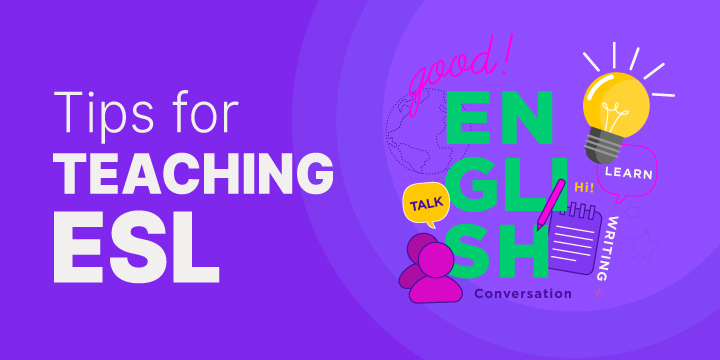Teaching English as a second language in today’s world is not only a teaching-learning activity but also an ever-growing industry.
The need for English for communication is becoming inevitable irrespective of the subject one is studying, and the profession one is opting for. From higher studies to international traveling, English is a constant companion.
People feel the need to join an ESL class when they understand the need for this essential skill to become helpful either in their present or future life.
The person approaching the students to convince them to join ESL classes must have a clear idea. They must discuss the benefits of having the ability to communicate in English and the problems one may face in the future of not having a specific skill.
If you’re wondering how to teach someone how to speak English, you should start by focusing on one skill at a time.
Among the four skills of language, namely Listening, Speaking, Reading, and Writing, if more than one skill is focused on at a time, the student may face information overload, and the teacher will lose the chance to divide the paid course into four parts.
So, the teacher needs to decide which skills they want to focus on. If more than one skill is being taught, the teacher should design and offer different paid courses for different skills. But they should also provide one free trial class for every student. It can be an offline or online face-to-face session or a pre-recorded lecture.
The four skills of language
Listening:

Listening has been defined as the “thoughtful attention one pays to what is heard.” It explains much of what Listening should be. We hear sounds and make meaning out of them and curate a response, quick or delayed, but for sure, we respond. If the sounds don’t mean anything or we don’t see them as part of the ‘interaction,’ we ignore them and refuse to react, even though we hear the sounds. Listening is the Primary Skill that makes us sensible humans.”
Listening is the first skill the teacher should focus on because if you don’t listen, you can’t speak. And if you don’t learn to speak, learning to read and write will become complex.
Speaking:

“We utter something, and it gets a response. If so, it is speaking. We make sounds in a defined or accepted language, and the listener is able to pay “thoughtful attention,” and the activity of speaking gets done. Oral Communication is the other name for Speaking Skills or Spoken Communication. This skill makes us look smart amidst a pool of people who have been listening to things but do not express by their vocal cords.
Oral Communication is crucial in the professional world now. The paralanguage features of pitch, tone, intonation, accent, etc., play a significant role in taking us to a good place in Speaking.”
There is one pivotal point when it comes to the question of how to teach someone how to speak English. Without the necessity and opportunity provided to the students, they will not learn to speak. The teacher should create the necessity for the students to speak in front of the class. It can be a discussion on any topic or a presentation on a topic of choice.
Reading:

Initially, we could do the following types of reading (as described by NCERT, Reading Development Cell):
- Children perfectly identify the letter, and they can read the words by connecting the letter.
- Children are able to read word-by-word from written or printed material.
- Children are reading only the contents that are handed over to them by their class teachers or parents. Basically, they read the academic books that are made for a subject.
None of these reading processes can foster the “joy of reading.”
Our reading has to be fluent, and we must understand what we read. This is only possible with practice. Reading is a literacy skill, and it is an excellent skill for those who can decode a script.
For teaching reading, the teacher should take the following steps:
- They must accompany the reading materials with either pictures or audio clips. This will allow the students to understand some of the phrases or sentences by guessing their meaning with the help of the photos.
- The audio materials will enable readers to understand the exact pronunciation of the word.
- Learning the exact pronunciation will help them remember the vocabulary quickly.
Comic books can be a perfect option for integrating reading with looking at pictures. Comic books will let the learners understand the meaning of sentences, phrases, and words in an identifiable context.
Writing:

“Reading makes a full man; Conference a ready man; and Writing an exact man.”
Sir Francis Bacon
Reading gives you an immense amount of knowledge.
Discussions enable readiness in you to express your views.
When you express your thoughts in writing, it makes you an ‘exact’ man. The world knows what is documented. In this case, even the voice recording can be considered ‘written.’ Whether we’re posting on Social Media or putting pen to paper, all of these are written.
Handwriting or cursive is not essential. However, the intricate interplay of vocabulary, grammar, and structure is.
Grammar plays a vital role here. Accuracy, brevity, and clarity (of thought and expression) are essential for impressive writing skills.
Writing should be the last skill taught. After learning to listen, speak, and read respectively, writing will be the final stage in language learning. Learning four skills related to language will give create a sense of acquisition. Acquisition generally happens in the case of the mother tongue or L1 or the first language.
The students should be allowed to be creative to perfect the skill of writing based on grammar. For example, the teacher can ask them to write on a topic of choice, which will be easy for them and will have a lot of potential to let the students use their creativity without any hesitation.
Essential aspects of Language to be focused on
Grammar:
Grammar consists of the rules for constructing phrases and sentences in any language. If the teacher is teaching English to students who are learning the language for the first time, they must focus on grammar. It will help them use their vocabulary to construct sentences in expressions and communication.
Vocabulary:
Vocabulary is the set of words used in a language to denote the different objects, expressions, etc. The teacher must involve the students in some activities to strengthen their vocabulary. Mere remembering the words with their meaning will not lead to the point of spontaneousness.
The Acquisition-Learning Distinction
“Language acquisition is a subconscious process; language acquirers are not usually aware of the fact that they are acquiring language, but are only aware of the fact that they are using the language for communication.”
Professor Stephen D. Krashen
Learning a language will become a natural process if an environment of language acquisition is created. For making the process natural, the teacher in the class should artificially generate the need for the students to communicate in the target language.
The best way for doing that is to involve the students in some activities where communication will be the main component—for example, discussing a topic or asking them to tell a story work.
In the case of children, the teacher can let them watch some animated clips and ask them to speak about what they have observed. The only rule will be to avoid using the first language and communicate only in the target language. A target language is a language the student is learning. In this case, English will be the target language.
Selling your English courses:
To grow your business of teaching English, the person will have to be helpful and friendly from the beginning. Making students feel more comfortable increases the chance of selling your courses. Apps like Wise can help you structure your courses better and give better engagement metrics for teachers and students.
From the very start, the teacher will have to understand one thing. They should not point out the weakness of any student in a manner that will raise anxiety. Increasing levels of stress will affect performance.
So, the teacher should be patient and motivate all types of students to stay within the process. But the teacher should always provide them the opportunities to work on their weaknesses. Besides that, the teacher should distribute free material as a method of promotion.
This can be done through handouts or prerecorded video lectures shared through social media. The advertisement should also contain clips from the teacher’s video lectures.




